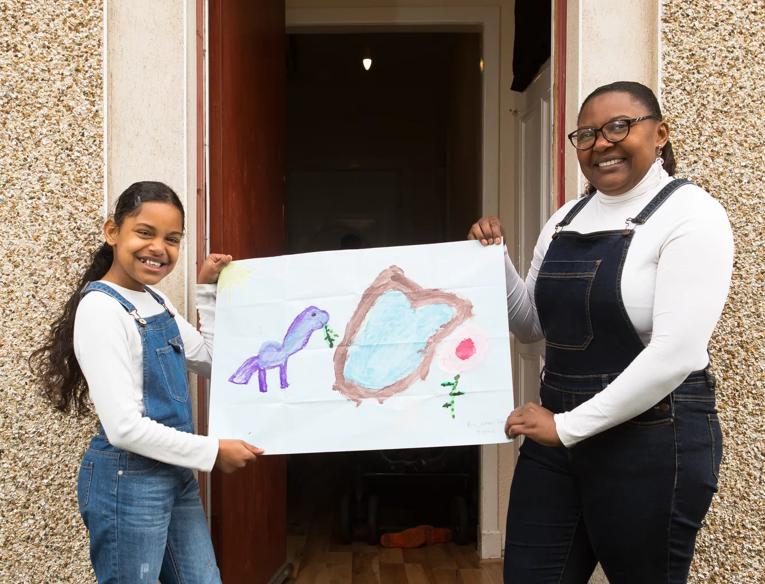Art by Post: Carol’s story
‘It was lovely to feel like I was part of a community producing art all over the country’.
Carol is a member of an arts group in Devon for people with mental health struggles. When the first Covid-19 lockdown hit, the group’s leader sent Carol and the other members a care package, which included booklets for our Art by Post project.
This is Carol’s story of how art, and the Art by Post project, has helped her to come through difficult periods with her mental health, and even helped in her recovery from illness, as told to Mina Holland.
Carol
Art by Post participant, 66, Devon

‘I’m a member of Flying Fish Artists, an art group for people with mental health struggles in North Devon, led by my occupational therapist, Joyce Reed. Flying Fish currently has about 25 members – with 10 regulars – and we’ve all become best friends. Even if you are feeling really bad, it’s safe to come to our group. We’ve all been there.
‘It was through Joyce that I accessed Art by Post. She made each of us a care parcel of materials to accompany Southbank Centre’s creativity booklets. Mine contained fineliner pens, watercolours, pencils of various softnesses, brushes, cartridge paper, a sharpener and a piece of locally-made soap. During the lockdowns, either at home or in person, under the huge canopy of the London Plane tree in Barnstaple’s Rock Park, we’d meet to sketch, paint, write poetry, take photos or make music together.
‘I love painting trees and I’ve done loads in lots of different ways. In fact, I like making art of, or with, trees in any medium. I recently took up whittling, picking a piece of wood from a tree that I wanted to work with and giving it new life in the form of something else; the first thing I made was a musical instrument. Trees are life-giving, we can never have too many, and they are an endless source of inspiration. I’ve also become fascinated by owls and how they can’t move their eyes. I started to make pictures of owls, first sketching and then adding the colours of oxidised metals – pinks, purples, golds, bronzes – a bit like an abalone shell.
‘When I’m well enough to do it, I love creativity. Sometimes I get into a horrible space in my head and I’m sucked into another world. I’ve had so many medications to help my mental health, but the only thing that really helps is finding my flow with my art. If I can manage to start something, I manage to get myself into a better place. People with mental health problems may not be able to do 9-5 jobs, but we want to be part of real things. Flying Fish has given us that opportunity, meeting up to make art and contribute to exhibitions all over the south west.
‘I’ve had so many medications to help my mental health, but the only thing that really helps is finding my flow with my art.’
‘Just before the pandemic, Flying Fish lost the Lodge, its dedicated building which we rented from the council, due to funding cuts. Until then, we’d all had our own key and could go and make art whenever we wanted – one guy was an insomniac and he’d go through the night. The combination of that and the effects of Covid-19 has been isolating for all of us. Now we hire a hall in Barnstaple once a week for a studio session. One lady still can’t come to our group because she doesn’t feel safe. She was just starting to come out of her shell – she really needs that group, and we need her.
‘Lockdown was horrible, but creatively it was wonderful – there were so few distractions. I actually got Covid-19 last year; I was really poorly with it and would wake up, unable to breathe through my mouth. I made art during my recovery though – nesting dolls, Christmas tree decorations, a portable nativity set...all to sell at a Christmas fair to raise money for the continuation of Flying Fish.
‘Lockdown was horrible, but creatively it was wonderful – there were so few distractions.’
‘Art is a way to make someone who is unwell feel connected – it promotes healing and conversation. I’ve seen this first-hand, both as a patient and in my work at North Devon hospital, where I’ve been part of transforming the corridors of the psychiatric wards with murals. In one, we painted a rainbow emerging from a river, with lots of dragonflies and insects and bumble bees gilded in 22 carat gold. We put a list up on the wall of all the hidden things you could find in the mural, and it really helped to engage patients who couldn’t otherwise be engaged.
‘The work that the Southbank Centre is doing for groups like ours is amazing, especially given how other mental health support is disappearing. I could get inspired looking at a blank wall – I don’t know what getting bored feels like! – but the Art by Post booklets were really inspiring, channelling my ideas into set tasks. It was lovely to feel like I was part of a community producing art all over the country.’

An exhibition of selected works submitted as part of Art By Post, debuted at the Southbank Centre in September and is now on a UK tour. It is currently at De Montfort Leicester University until 19 February.
Carol was talking to Mina Holland. Deputy Editor of Guardian Feast, Holland writes about food, lifestyle and culture and is the author of The Edible Atlas, and Mamma: Reflections on the Food That Makes Us.



